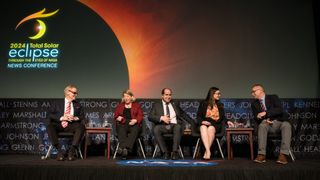
[ad_1]
The countdown until the total solar eclipse is now under two weeks, and even NASA can’t contain it’s infectious excitement for this rare solar spectacular!
On April 8, 2024 for the first time since 2017, millions of people will have an opportunity to watch the moon pass in front of the sun creating a surreal spectacle both in the sky and across the face of the Earth. And if you’re lucky enough to be in the path of totality, for minutes it will become mesmerizing as day becomes night and the stars get the rare chance to twinkle during the day.
With the big day swiftly approaching, NASA leadership held a briefing on Tuesday (March 26) to discuss the science experiments the agency will be conducting during the total solar eclipse on April 8.
“Eclipses have a special power. They move people to feel a kind of reverence for the beauty of our universe. Their power is not only to unify us on Earth, but to further science and discovery,” Bill Nelson, NASA Administrator, said during the briefing. “In 1919, Albert Einstein’s theory of gravitational bending was proven when scientists measured how stars shift when the sun is blocked out by the moon. And today, over a century later, a total solar eclipse still brings great opportunity and science.”
Related: Total solar eclipse 2024: Everything you need to know

First and foremost, safety needs to remains a top priority. NASA officials remind those who will be outside taking it all in to have specialized eye protection for your eyes as well as on camera lens, binoculars, and telescopes for the entirety of the event to prevent serious eye damage as well as being aware of your surroundings and how you plan to watch it.
“During the eclipse, we want to make sure that we’re not relying on our standard lights on our cars. We want to make sure that we’re looking out for the pedestrians. It’s really important to make sure that we stay focused on everyone around us as people are probably going to be stopping,” James Free, NASA Associate Administrator, also shared.
“When you think about the power of the sun, what we’re doing with other celestial bodies, we’re blocking out the sun with coronagraphs in the future, to look at the habitable worlds around those. That’s the inspiration that we can all take away from this.”

In addition to individual memories being made, the science discoveries that NASA will be able to pursue is also invigorating. NASA’s Heliophysics System Observatory will deploy rockets, planes, and balloons in addition to taking observations from the surface to further our knowledge on eclipses and their impacts.
These experiments will take place to study Earth’s atmosphere (the ionosphere, specifically) and eclipse weather both on our planet and in space. And, for those curious minds, NASA encourages participants to become citizen scientists during the event.
“I’m highlighting just three of the over 40 projects that folks can participate in,” Kelly Korreck, NASA Program Scientist said. “The first project is sun sketcher — it utilizes a smartphone to help understand the size and the shape of the sun better. The second project is focused on the reaction of our atmosphere to the eclipse. It’s called globe observer and this app has you record things like temperature to understand the effect of the eclipse on the atmosphere and clouds.
The third project is eclipse soundscapes that you will explore the wildlife on the eclipse and the sounds that you will experience during it. These are just a few of the ways to engage with the eclipse and NASA Science. The eclipse is not just a stunning visual experience and I hope you will join us in these discoveries!”
[ad_2]